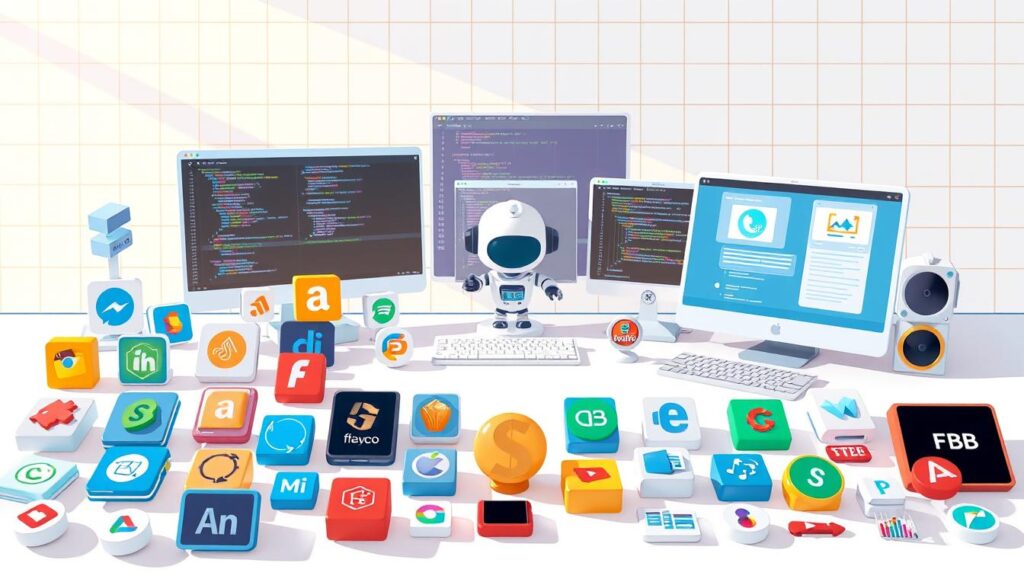Traditional coaching faces challenges like time zones and high costs. An AI coach offers a new solution. Tools like ChatGPT, launched in 2022, can create content as vast as 100 courses. But, free AI content has flooded the market, reducing its value.
Transform your blogs or FAQs into training data for an AI chatbot. Coaches like Graham Cochrane use AI to scale personalized advice. They clone their expertise into virtual coaching tools.
Klarna’s AI chatbot handled 2.3 million interactions, cutting repeat questions by 25%. It works like 700 agents, saving time. Your AI can automate client support, creating passive income.
The online era is golden: platforms let you monetize digital knowledge. Experts like Alex Hormozi and Tai Lopez profit using AI strategies.
Build your AI chatbot today. Train it with your content. Offer 24/7 support, boosting reach and earnings. Join the shift to AI-powered knowledge sharing and turn your expertise into a revenue stream that never sleeps.
Monetize Your Know-How with a Chatbot: Turn Expertise into a 24/7 AI Coach
The AI coaching revolution is changing how we share knowledge. Now, your skills can work 24/7, thanks to AI. This means you can help more people without getting tired.
Old ways of coaching have big limits. They can be expensive, time-consuming, and limited by where you are. But, chatbots can solve these problems.
Understanding the AI Coaching Revolution
Think of a chatbot that learns from your podcasts, videos, and books. Tools like Dialogflow or IBM Watson can make your teaching style their own. Graham Cochrane’s AI coach is a great example of how this works.
The chatbot market is growing fast, reaching $9.4 billion by 2024. This shows how big the change is. Your knowledge can now be a digital asset, ready for anyone, anytime.
Why Traditional Coaching Has Limitations
Human coaches can only help a few at once. They are expensive and can’t reach people in different time zones. But, AI changes all that.
Your chatbot can answer questions fast, all day, every day. This means more people can get help, without you spending a lot of money or time.
How AI Chatbots Are Transforming Knowledge Sharing
Chatbots make sharing knowledge easy and big. Over 300,000 businesses use them to talk to 1.3 billion users. This shows how far they can reach.
Unlike humans, AI never gets tired. It can handle hundreds of questions at once. This means your knowledge can help more people, all the time.
Benefits of Creating Your AI Coach Chatbot
Imagine coaching thousands without being there in person. AI coaching benefits make this real. Your chatbot works all day, every day, without breaks.
For example, Coach Maja helps creative entrepreneurs while her creator takes care of family. This scale coaching business model lets you grow your income without extra stress.

Scale Your Coaching Without Time Constraints
Traditional coaching is limited by your schedule. But with coaching automation, your chatbot answers questions right away. Your expertise is always available, no matter where or when.
Passive Income Through Automation
Offer subscriptions or one-time fees for passive income with AI. Once it’s up and running, your chatbot makes money without needing you every day. Use data to improve your offerings and increase earnings over time.
Expanding Your Reach to Global Markets
Customize languages and offer 24/7 access for global coaching reach. Clients from all over can connect with you, expanding your market without needing to travel. You can also use cultural insights from data to tailor your content for different audiences.
Data Collection and Enhanced Client Insights
Track how users interact with your chatbot to find trends. Client data insights show what topics are most important to them. This helps you improve your services over time.
Identifying Your Valuable Expertise Worth Monetizing
Every blog post, video, or course you’ve created holds clues to your monetizable expertise. Start by conducting a knowledge assessment of your existing content. Organize your work into an expertise inventory—note recurring themes, frameworks, or advice that resonates with your audience. This process reveals gaps and opportunities for value proposition development.
Pinpoint areas where your expertise differentiation shines. Ask: What solutions do users repeatedly seek? Analyze top-performing content and FAQs to gauge market demand. For instance, a fitness coach might discover a niche in postpartum recovery, while a writer identifies demand for SEO-optimized blog templates. Use surveys or analytics to validate these insights.
Compare your unique methods against generic AI tools. If your approach to time management or creative strategy differs from ChatGPT’s generic advice, that’s your competitive edge. Your value proposition hinges on blending this uniqueness with audience needs. By 2025, 80% of companies will rely on AI for decisions—positioning your distinct expertise now secures your place in this shift.
Tools like Tars or Botsify simplify turning this analysis into actionable AI products. Prioritize topics with high demand and low competition to maximize ROI. Your journey starts here: transform overlooked content into a roadmap for building a profitable, personalized AI coach.
Technical Steps to Build Your AI Coaching Chatbot
Building an AI chatbot doesn’t need coding skills. Start by picking an AI platform that fits your level of expertise. Tools like Coachvox AI, BotPress, or OpenAI’s GPT Builder make AI chatbot development easy with simple interfaces. These AI platforms let you add your content—like blogs or FAQs—directly into their systems. This automates the 
Selecting the Right AI Platform for Your Knowledge Domain
Compare platforms like ChatGPT, Microsoft Bing AI, and Google Bard to see which fits your needs. HuggingChat offers customization for developers, while UBOS AI Bot Template is for no-code solutions. Look for apps like Zapier, which connects chatbots to 7,000+ tools for automating workflows. Choose based on user reviews and pricing to meet your goals.
Creating a Knowledge Base from Your Expertise
Turn your knowledge into structured data. Use blog posts, training materials, or video transcripts to create prompt-response pairs. Coachvox AI’s tools can automatically organize these into a knowledge base. Start with important topics like FAQs or common client questions. Good data ensures your chatbot gives accurate, personalized advice.
Training Your AI to Respond in Your Voice and Style
Make your chatbot sound like you with AI voice training. Platforms like Gram AI can mimic your speaking style, and GPT Store has templates to match your language. Upload conversations or scripts to teach the AI your way of speaking. Test its responses to make sure they match your brand voice.
Testing and Refining Your Digital Coach
Start chatbot testing with sample questions. Track how well it answers and how happy users are. Use Google Analytics to watch how people interact. Keep improving your chatbot by adding new data or tweaking training inputs. Regular updates help keep your AI up-to-date with client needs.
Pricing Models and Monetization Strategies
Creating the right AI coaching pricing and chatbot monetization strategies helps your knowledge reach the right people. It also helps you make more money. Look into subscription models, tiered coaching services, or hybrid coaching models to meet client needs. How you price things affects how people see value, so being clear and open helps more people buy.
Subscription-Based Access vs. One-Time Purchases
Coach Maja offers €15/month or €150/year plans. This shows how subscription models can bring in steady income. Monthly plans are good for those watching their budget, while yearly plans save money.
Botsonic’s platform makes billing easy, allowing you to automate renewals and track how well things are doing. About 67% of users like flexible pricing, making subscriptions a great choice for growing your business.
Tiered Service Levels for Different Client Needs
Provide tiered coaching services to fit different budgets and needs. Start with a free tier for basic advice to attract users. Then, offer premium tiers with more features like live sessions or special resources.
Botsonic’s analytics help you see which features users like most, helping you adjust prices. For example, one fitness coach saw a 40% increase in revenue by adding premium features.
Complementing Your Human Coaching with AI Assistance
Hybrid coaching models mix AI with live support. This way, you can handle more clients without losing personal touch. Use chatbots for simple questions, so you can focus on important sessions.
Businesses using hybrid coaching models see a 70% increase in client loyalty. Botsonic’s connections with WhatsApp and Messenger let you reach users anytime, keeping them engaged 24/7.
Marketing Your AI Coach to Potential Clients
Effective AI coach marketing begins with showing how your digital coach solves real problems. Use digital coach promotion strategies to highlight 24/7 access and personalized support. Live AI coaching demonstration videos can attract prospects by showing how your chatbot helps users overcome challenges.
Platforms like Descript make creating these demos easy. They turn complex details into scenarios people can relate to.
Boost chatbot client acquisition by teaming up with health, business, or education platforms. Offer free trials to let users try out features like Graham Cochrane’s Gram AI conversation memory. This feature keeps session details for easy follow-ups.
Share testimonials from early adopters who appreciate instant answers and time saved. These are key benefits driving chatbot adoption.
Use client education content to address any doubts. Blogs and webinars can explain how AI works with human coaching, not against it. Highlight studies like Harvard’s, which found AI tools can cut task time by 25%.
Showcase case studies, like Coachvox AI’s ability to offer scalable, personalized interactions. This builds credibility.
Optimize landing pages with clear calls-to action, placing your chatbot where visitors are most active. Tools like Frase can auto-generate SEO content to explain benefits. Midjourney visuals can make complex ideas like “emotional analysis” or “goal tracking” more engaging. Being open about your AI’s capabilities helps build trust, ensuring clients understand its role in their journey.
Conclusion: Transforming Your Expertise into an Always-On Digital Asset
The future of AI coaching is here, and turning your skills into digital assets is key. Old coaching methods are outdated when you use AI. Now, your knowledge can work 24/7, thanks to tools like ChatGPT’s 800+ plugins and AI Chatbot Builder.
These tools help you create global tools, fighting the flood of information today. Your skills won’t get lost; they’ll grow stronger.
Investing in AI coaching starts with affordable tools like Writesonic ($19/month) or AI Data Analyst. You can train your chatbot with your existing content. This strategy lets you make money from your knowledge.
Offer subscriptions or different pricing levels and track how well it works with A/B JUDGE. Over 50,000 advertisers on ad4mat show there’s a big demand for personalized AI solutions. The work you do now can earn money for you even when you’re not working.
First, check what content you have. Put it on a secure platform like AI Chatbot Builder and test it. Start with a simple chatbot for FAQs or guiding new customers. Businesses using AI tools make thousands each month, showing it’s not just a trend but a way to earn money while you sleep.
The AI coaching future is bright for those who start early. It’s time to turn your skills into digital assets. Start building your digital knowledge asset today.
